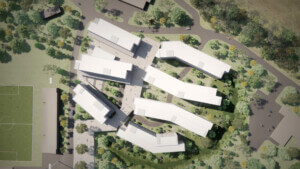In the New York City mayor’s office, the council chamber, and one borough president’s headquarters, officials are hashing out critical—and competing—land use reforms that could impact at least one major development in lower Manhattan.
One reform is a slate of new rules from the mayor’s office while the other is legislation in the city council; both are making their way right now through the review and approvals process.
Currently, there is no unified process for the removal or modification of deed restrictions (the legal covenants that outline the use of land). As deed restrictions limit the use of a property, potentially reducing its value, there is often incentive to have those restrictions lifted. Deed restrictions are also widespread: The Department of Citywide Administrative Services (DCAS) and other city agencies have put (or have grandfathered in) deed restrictions on thousands of city properties, both through the sale of city-owned parcels and through the Uniform Land Use Review Procedure (ULURP).
The mayor’s office has introduced agency-level reforms to address shortcomings in the deed restriction modification process. DCAS is holding a hearing next week on these reforms. The mayor’s rules call for a review process with a public hearing, plus a stipulation that the community board, borough president, and appropriate councilmember be notified of the pending changes.
Parallel to the mayor’s reforms, Manhattan borough president Gale Brewer and city councilmember Margaret Chin are advancing legislation that would, among other measures, subject deed modifications to a more rigorous public review.
Although Chin and Brewer’s bill, Intro 1182, grew from public outcry over the lack of oversight around the removal of the Rivington House deed restriction, Chin’s district also includes 28 Liberty (formerly known as One Chase Manhattan Plaza), another flash point property. Its owner, global developer Fosun, is pushing to modify the deed restriction to construct 11- to 17-foot-tall glass entrances to below-ground retail on the landmarked plaza.
Both the mayor’s rules and the Intro 1182 have special importance for Manhattan Community Board 1 (CB1). 28 Liberty lies within the CB1’s boundaries and, in a mirror of the citywide conversation, the property has been a controversial issue for the board since the Landmarks Preservation Commission (LPC) approved changes to the landmarked plaza last year. At the CB1’s Planning Subcommittee meeting last week, CB1 board members debated a resolution on deed restriction modifications that will go before the full board at their October 28 meeting.
In drafting the resolution, board members repeatedly raised three points: The difference between a “major” or “minor” deed restriction, how that difference should be determined, and by whom. Currently, there’s no system in place determine that difference—a minor modification to some could be a radical change in use to another observer, as the ongoing discussion around 28 Liberty’s pavilions illustrates.
“From what we’ve seen, putting a deed restriction in place seems to always benefit the public,” said James Caras, the borough president’s general counsel and director of land use. He added that the burden of proving the benefit of substantial deed modifications or removals should fall on the entity seeking the changes. The borough president’s office believes that deed modifications that change the use of a property would “probably benefit” from public review under Brewer and Chin’s proposed law. If a developer wants to change the use from public to private, for example, that action may be subject to ULURP, while a continuation of public use may not be.
In soliciting the public’s voice, Intro 1182 has precedent. Right now, deed restrictions that were the result of a ULURP must be removed through the same process. Intro 1182 would subject major modifications, which are typically granted per the administrative procedures of the DCAS, or the relevant agency, to a ULURP—what they call “the gold standard of public review.”
In September 2016 testimony given to the Council Committee on Governmental Operations and the Committee on Investigation, Brewer and Chin raised considerable objections to the proposed DCAS rules. The rules’ foundations, they said, would not be as strong as the competing law passed by the council, as rules could be changed at any time by the agency itself or by the next administration.
As CB1 planning committee member Reggie Thomas pointed out, a ULURP process can be prohibitively costly and time-consuming. Yet, during the meeting there seemed to be a consensus from the board on some kind of public review when the proposed deed changes involve a switch from public to private use. CB1 chair Anthony Notaro called the decision-making process for other properties “a gray area,” but said that regardless, the community “should be on the front line, one of the hurdles, before any decision is made.” Specifics like these, Caras said, would be worked out in legislation.
In light of the lifting of deed restrictions at Rivington House and the Dance Theater of Harlem, as well as continuing conversation around 28 Liberty, Brewer’s office is reaching out to each community board in its jurisdiction to answer questions about the pending reforms.
Until the city and the council hammer out their respective plans, though, there’s no clear process on how to modify deed restrictions, so projects like 28 Liberty are treading water.
While plans on file with the Department of Buildings (DOB) show that interior upgrades are progressing, construction on the plaza’s glass pavilions appears to be on hold, because the project can only move forward if a deed restriction regulating the height of objects on the plaza is removed. The LPC-issued Certificate of Appropriateness from November 2015 states that no work on the plaza can begin until the agency has received and reviewed the final DOB filing set of drawings, specifications, and a scope of work that details the restoration of the on-site Dubuffet sculpture and Noguchi garden.
A spokesperson for the LPC confirmed that the agency has not received DOB specs or drawings. In a statement, Fosun said “all Landmarks Preservation Commission comments regarding the Dubuffet sculpture and Noguchi garden have been resolved to the satisfaction of the LPC,” adding that interior work continues to “prepare for the exterior work.” At press time, The Architect’s Newspaper (AN) was able to confirm that the scope of work for the restoration of the Noguchi garden was on file with the LPC. (As a freestanding object, the Dubuffet, it turns out, is not part of the landmark’s designation and is thus outside of the LPC’s purview.)
Fosun declined to comment on the status of the glass pavilions, reasons for the delay, and whether construction documents exist for the plaza modifications. New York–based SOM, the architect for the project, also declined to comment.
In July 2016, Bloomberg News reported that Fosun is preparing to sell $6 billion in assets between now and the end of next year in an effort to raise its junk credit rating and alleviate its massive debt, although AN was able to confirm the seeming hold-up on the plaza is unrelated to Fosun’s financial status.
On Tuesday night the CB1 planning committee revealed its resolution to the public. It called the reforms drafted by the mayor’s office and DCAS “neither sufficient nor in the public interest” due to the fact that they may be easily changed by another administration. The board instead supports a legislative process and expressed support for elected officials as they research the kind and quantity of deed-restricted properties (there’s no unified database right now) to create “an appropriate process” for deed restriction modification or removals.
The full CB1 board approved the resolution unanimously.










